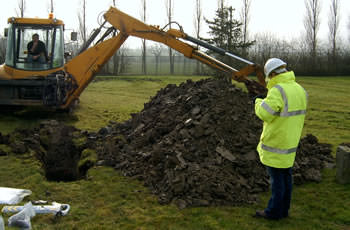
Trial Pit Excavations This technique is normally used for recovering near surface large bulk samples of granular soil or if close visual examination of the strata is required. The main advantage of this method when compared to percussion drilling is the relative speed with which the work can be carried out. The disadvantage is the level of surface disturbance suffered and the difficulty in carrying out the effective reinstatement of the excavations. Trial pits can be formed where the ground will be able to stand temporarily unsupported. Where there is water present in the excavation, problems may be presented due to instability of the sides and the difficulty of obtaining representative samples of the ground (finer material tends to wash out with the water as the sample is collected). Entry of the excavation by personnel must be avoided, since the unsupported sides of a trial pit can collapse. If it is essential that an excavation be entered, e.g. for the collection of undisturbed samples or to enable in-situ testing to be carried out, then shoring must be used or the sides of the trial pit battered back to a safe angle. Trial pits can be safely manually excavated down to about 1.2m. Hand excavation is necessary if services (water, gas, electricity, etc.) are known to exist in the vicinity and particularly if their location is uncertain. Once the base of the excavation is below the depth at which any services may exist, then the excavation can be continued by machine. A wheel-driven back-hoe excavator is appropriate for excavating trial pits to a depth of about 3m. Some machines of this type are capable of excavating down to about 5m. A track-driven machine is necessary to reach depths beyond about 4.5m. However, if groundwater is encountered, deeper excavation and sampling may be difficult and of limited value. |
Call 01603 250754 or click here to send an enquiry by email